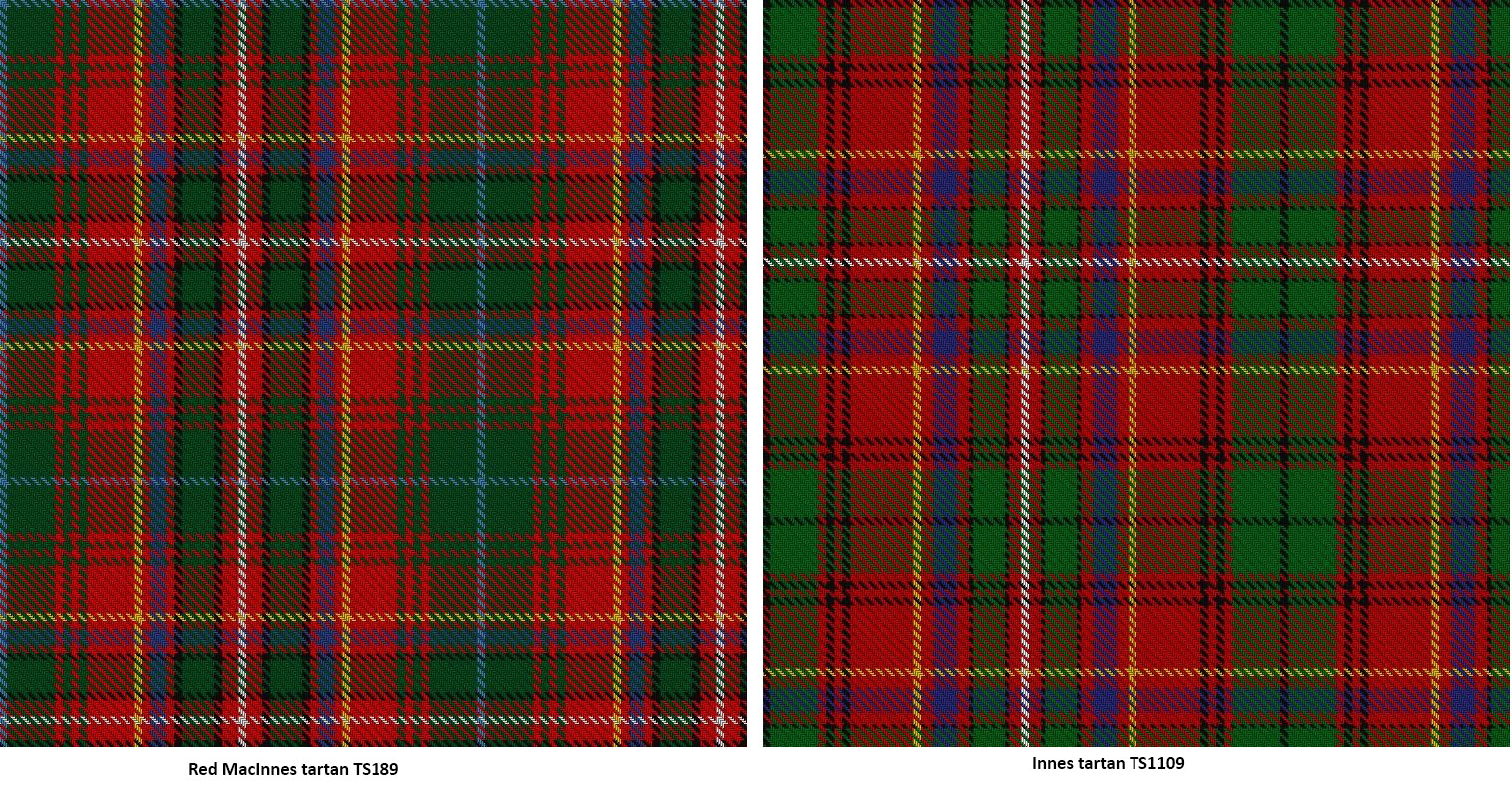MacInnes Red Tartan (TS189)

(for a larger view click on the tartan - 266K PDF)
This sample comes from the MacGregor-Hastie collection which forms the basis of the cloth archive of the Scottish Tartans Society. Some of the samples, including this one, were unmarked. One can assume that the sample dates between 1930 and 1950. The source of tartan 189 was: MacGregor-Hastie Collection
You will have to be careful with this tartan, the MacInnes red 189 has a specific threadcount but is very similar to the Innes TS1109 shown below, and another Innes TS3387 is also close. Many mills calls the MacInnes the Innes, and the difference is so subtle you can hardly see a difference. Innes claims the red to be theirs but MacInnes does have a specific red for their own.
Threadcount:
A4 G24 R4 G4 R4 G4 R24 Y4 R4 B8 R4 K4 G16 K4 R8 W4
Pallet:
A=3C82AFBLUE; G=005020MOD GREEN; R=DC0000RED; Y=E8C000YELLOW; B=2C4084BLUE; K=101010BLACK; W=E0E0E0WHITE;
The threadcount is usually provided as a series of capital letters and numbers. Each capital letter represents a colour in the tartan and the number beside each letter dictates the precise number of threads required so that the weaver can set up the loom accurately. For example
B24 W4 B24 R2 K24 G24 W2
Means 24 threads of B (blue) followed by 4 threads of W (white), 24 threads of B (blue), 2 threads of R (red), 24 threads of K (black), 24 threads of G (green), and another 2 threads of W (white).
Tartans are either symmetrical/reflective patterns or asymmetrical/repeating patterns. The threadcounts for these two types of patterns are presented slightly differently so that the weaver knows which type of pattern he is setting up on his loom.
This tartan is somewhat controversial. Donald MacInnes writes:
"The 'red tartan' mentioned is the old Dress MacInnes Tartan. Sometimes
erroneously referred to as the 'Innes' tartan and worn for many years as such."
"John MacInnes based his green Hunting MacInnes Tartan, designed at the
turn of the
the last century, on the older red tartan. A comparison of these tartans shows
clearly the similarity." (reference MacInnes of
Onich tartan)
" Thomas Smibert published a book in 1850 entitled the Clans of the Highlands
of
Scotland in which he assumed the MacInneses and Inneses were the same clan.(
Dr
Patrick Barden an expert on Scottish Heraldry made exactly the same mistake
when
we were talking a couple of months ago) Smibert is the root of the confusion!
This error was compounded by Sir Thomas Innes of Learney the late Lord Lyon."
The Scottish Tartans Society wrote in 1992: "Count No.2 shows the
commonly
seen Innes tartan, previously also known as the Dress MacInnes. This sett
appeared in Thomas Smibert's 'The Clans of the Highlands of Scotland' 1850,
as
Inness of Moray and for this reason Innes of Learney appears to have made this
pronouncement. However, W & A K Johnston in their 'The Tartans of the Clans
and
Septs of Scotland 1906, 2 Vol. show both the red and green (labeled Hunting)
under the name MacInnes. Innes of Learney says "the true Clan Aonghais
(MacInnes), is that given in MacIntyre North's Book of the Club of the
True
Highlanders, as taken from Logan's (James Logan, The Scottish Gael 1831)
original
list which is green and red predominant". One must assume that he is referring
here to the red sett, and apparently contradicting own his statement concerning
the disposition of these two tartans"
"The 'Clan Innes' does not appear in the famous R R McIan and James Logan's
Costumes of the Clans. The Clan MacInnes does appear with an illustration
of
the famed MacInnes Warrior at the Battle in Morvern."
"So in a word Smibert made a simple error - the Lord Lyon in good faith
accepted
the error - and because of the weight of authority of the Lord Lyon of that
time,
Inneses have been wearing the red MacInnes tartan believing it to be their own
to
this day. The red MacInnes seems to be more popular in Scotland than it is in
the USA."
Reference: Donald MacInnes of Cumbernauld, Scotland. Email,
February 20, 2001. Private correspondence.
Here is a correspondence from the Scottish Tartan Society in 1992 on the MacInnes vs Innes tartan.
Here is a rather lengthy document written by Thomas Innes, Feb 1931 in the Scottish Notes and Queries book. It talks about the Innes and MacInnes tartans and why the confusion. This piece was provided by Donald MacInnes, the original book was not found online although a number of these Notes and Queries are there.
Tartan registry information for Innes TS1109 here.
Threadcount, Innes on top, MacInnes below
K4 G24 R4 K4 R4 K4 R32 Y4 R6 B12 R6 K2 G16 K2 R6 W4
A4 G24 R4 G4 R4 G4 R24 Y4 R4 B8 R4 K4 G16 K4 R8 W4
Pallet: Innes on top, MacInnes below
K=101010BLACK; R=C80000RED; W=FCFCFCWHITE; Y=E8C000YELLOW;
B=2C2C80BLUE ;G=006818GREEN;
A=3C82AFBLUE; G=005020MOD GREEN; R=DC0000RED; Y=E8C000YELLOW;
B=2C4084BLUE; K=101010BLACK; W=E0E0E0WHITE;
Here is a side by side comparison, click on the image to get a large sized picture.
There is a red Innes of Moray tartan, TS3387 that also looks very similar, but the threadcount is quite different, even at this scale you can see the difference. The Scottish Register of Tartans calls this the incorrect MacInnes, but I think they are wrong. The Innes TS1109 is left, MacInnes center and Innes TS3387 right.
Click on the image for a larger view.
Reference for MacInnes red The Scottish Register of Tartans

